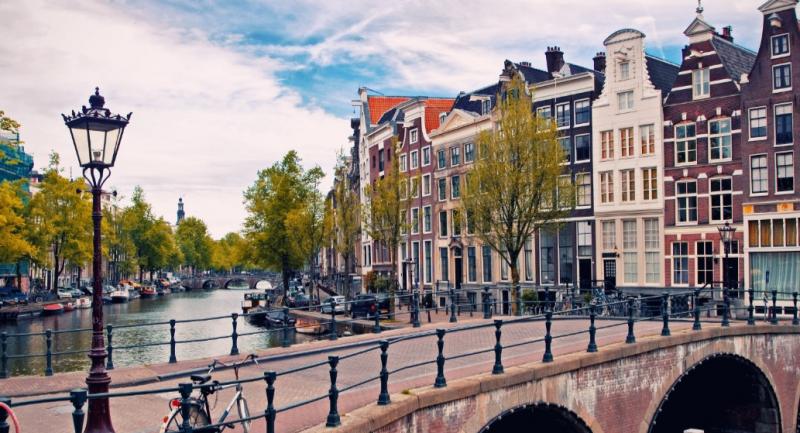
Amsterdam by Neighbourhood
Land of excessive vowels, tulips, windmills, clogs, liberal drug policies, red light districts and wonky houses. There are more bicycles than residents and a houseboat specifically for stray and abandoned cats. There’s a city poet and a ‘nightlife mayor’, and over 100km (62mi) of canals. Amsterdam is an eternally popular city break for all manner of reasons – its core centre has scarcely changed since the days of Rembrandt, yet it’s as modern a capital as it’s possible to be, with luxury shopping, innovative restaurants and a thriving nightlife far superior to its seedy reputation. Although not overwhelmingly large, Amsterdam is big enough that it has organically developed its own little microcosms – neighbourhoods with enough character and charm in themselves to spend your entire weekend there. We’ve hunted out some of the best, popular with locals and tourists alike, to give your Amsterdam stay an injection of something different.
Jordaan
Originally a working class neighbourhood, 2017 Jordaan exemplifies the peaceful, quintessentially Dutch way of life that we all come here for a piece of (at least, those of us not on a stag do). The rags-to-riches tale of run-down ghetto into gentrified neighbourhood Cinderella – think Brooklyn in New York, Shoreditch in London – is a well worn one, but Amsterdam’s Jordaan is now the most desirable area of town and rent prices can be astronomical. The biggest tourist attraction is undoubtedly the Anne Frank House, which I would hope needs little introduction – expect long queues though, as it can get busy in high season. Otherwise, the Jordaan is largely devoid of major sights – it’s a place for strolling, stumbling on hidden boutiques and absent-mindedly dawdling in galleries and cafes. Come on a Saturday for the organic farmer’s market on Lindengracht – it does excellent ham and cheese sandwiches, Dutch herring and fresh juices to enjoy with legs dangling over the canal.
TOP TIP: Enjoy the city’s best apple pie at Winkel 43 – but come hungry as portions are huge!
De Pijp
No-one really knows what ‘De Pijp’ refers to. Perhaps the pijps (pipes) are the neighbourhood’s long narrow streets that look a bit like plumbing, or it could be that there used to be a gas company here that supplied energy to the good people of Amsterdam. De Pijp is also sometimes known as the Latin Quarter, a nod to the swathes of immigrants who have injected the region with the kind of vibrancy only multiculturalism can – yet ‘Latin’ scarcely begins to cover it: Islamic butchers jostle for space with Turkish delicatessens, Indian textile shops, Spanish groceries, Lebanese restaurants, Chinese takeaways, Thai haute cuisine. Needless to say, the number of eateries, bars and cafes per capita in De Pijp is pleasingly high. I had one of the best breakfasts of my life (not an accolade I give away lightly) here, at Aussie-owned Bakers & Roasters. It’s not as picturesque as Amsterdam’s famous canal district, but its lively and eccentric population have made De Pijp a popular haunt for creatives, students and bohemian spirits since the 1960s.
Nine Streets
The sweetheart of Amsterdam’s shopping scene, the Nine Streets lie just five minutes’ walk from central Kalverstraat, which sags under the weight of chain stores and international brands. Some said it was a stupid name, but De 9 Straatjes has since become Amsterdam shorthand for indie shopping heaven: retro furniture, vintage accessories, luxury lingerie, trendy boutiques, musty record shops, quirky galleries and even cutting edge couture. Karl Lagerfeld commands the same terrain as the National Museum of Spectacles. Its fashion credentials are strong: up and coming labels sit pretty beside family-run ice cream shops and established fashion houses. Streets still bear the names of the thriving trades of yore, particularly in animal hides and leather goods – Wolven-, Beren-, Huiden-. Nine Streets is often touted as Amsterdam’s most photogenic neighbourhood: the architecture is quirky and iconic, the cobbles appropriately atmospheric, the views over the 17th century canals everything you think of when you think of Amsterdam, but there’s an intangible buzz about De 9 Straatjes that just can’t be captured on camera.
Museum Quarter
The bulk of Amsterdam’s cultural wealth is concentrated here in the 19th century Museum Quarter – home to the world-famous Rijksmuseum, the Stedelijk Museum of Modern Art, the Van Gogh Museum and the city’s premier concert hall, the Concertgebouw (get here on a Wednesday afternoon when it regularly throws open its doors for free concerts). You will also have undoubtedly seen photos of tourists lolling around the red and white ‘I amsterdam’ letters, the city’s most photographed attraction, while the imposing historical edifice of the Rijksmuseum looks on like a disapproving parent in the background. The gallery itself is home to one of the most comprehensive collections of Dutch 17th century Golden Age paintings in the world – all the Rembrandts and Vermeers and Van Ruisdaels that artistic appetites could ever wish for. And if you’re in need of an antidote to all this culture, the sprawling greenery of the Vondelpark, Amsterdam’s most famous urban park, is just a short walk away... as is the Heineken Experience, which, most importantly, includes free tastings.
Oud-West
Back in the 17th century, Oud-West’s most prominent hotspot was a teeming ‘Pest House’, where plague victims and other persons afflicted with horrendous, communicable diseases were sent to be isolated away from the general population. Luckily for us, Oud West today is one of the city’s most diverse neighbourhoods, and something of a secret. Few people venture this far from the warm tourist embrace of Dam Square and therefore miss out on a slice of authentic Dutch daily life. There are markets aplenty – Ten Katestraat radiates an old-fashioned village vibe, with a thriving local market tucked away down a residential street selling everything from potatoes to bicycle bells (it’s Amsterdam after all). The culinary and cultural hub of De Hallen is housed in a former tram depot, and boasts an indie cinema, library, several art galleries, a boutique hotel and plenty of hipster-proof coffee shops and concept stores, but the impressive Foodhallen indoor food market is its star attraction. Head to Oud West at night for some of Amsterdam’s best music venues, beer halls and cocktail bars.
Noord
‘Up and coming’ is usually estate-agent-speak for decrepit, run-down, bit of a wasteland, don’t go there at night. Amsterdam Noord was definitely ‘up and coming’ in the late 90s, but as with many of the world’s former industrial neighbourhoods left to rot and ruin, in step the hipsters, the creative, and the artists to work their magic and transform the empty lots and bleak warehouses into some of the city’s most interesting haunts. Directly across the water from Central Station, Noord was cut off from the rest of the city by the harbour for years, and even today is something of an escape for those in the know. It’s a land where two worlds collide – that of open green expanses dotted with windmills and 12th century villages, and cutting edge architecture, ambitious redevelopments and stylish waterside eateries. Noord is a mecca for cultural pilgrims and cyclists alike, with high-profile projects like the EYE Filmmuseum and A’DAM Toren with its revolving restaurant and rooftop swing, as well as miles of unspoiled countryside, indoor skate parks and former shipyards turned street art temples.
Top Tip: Stay at industrial chic Sir Adam Hotel in A’DAM Tower for a free-spirited atmosphere and excellent city views.
Share this article:




















